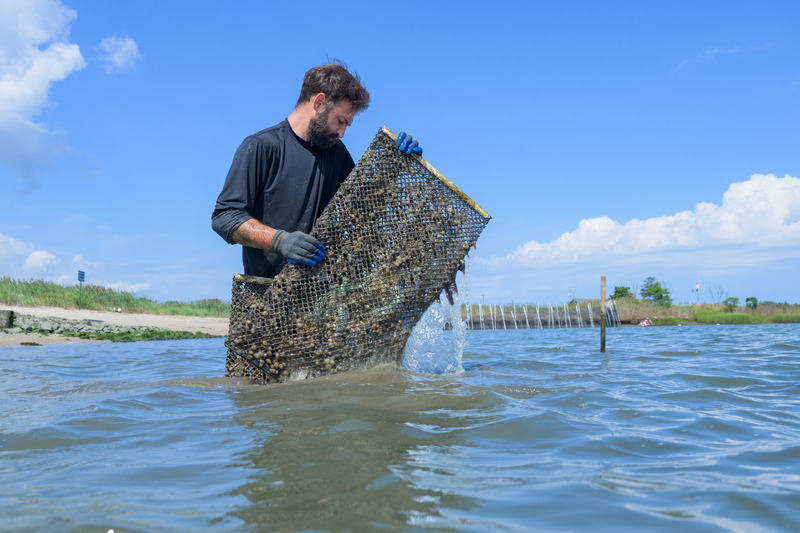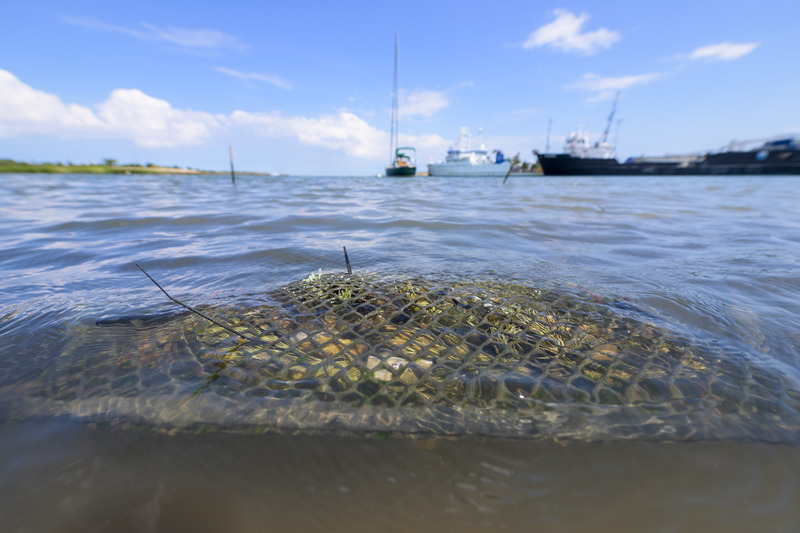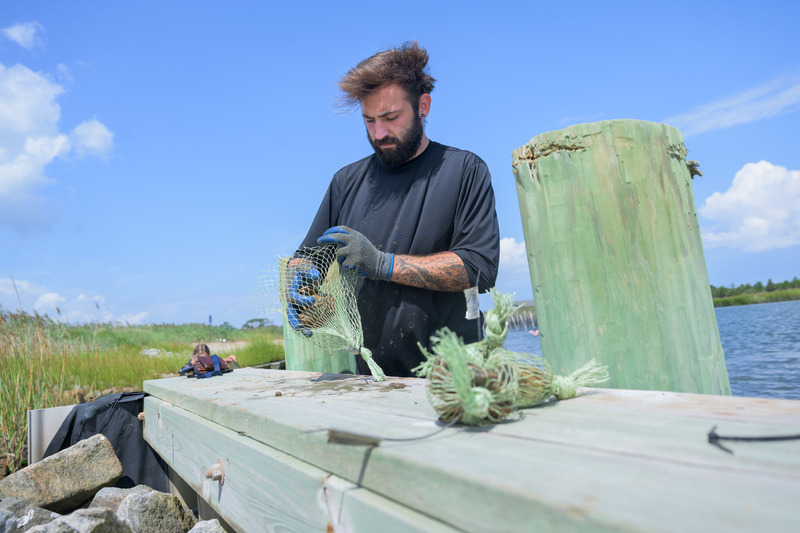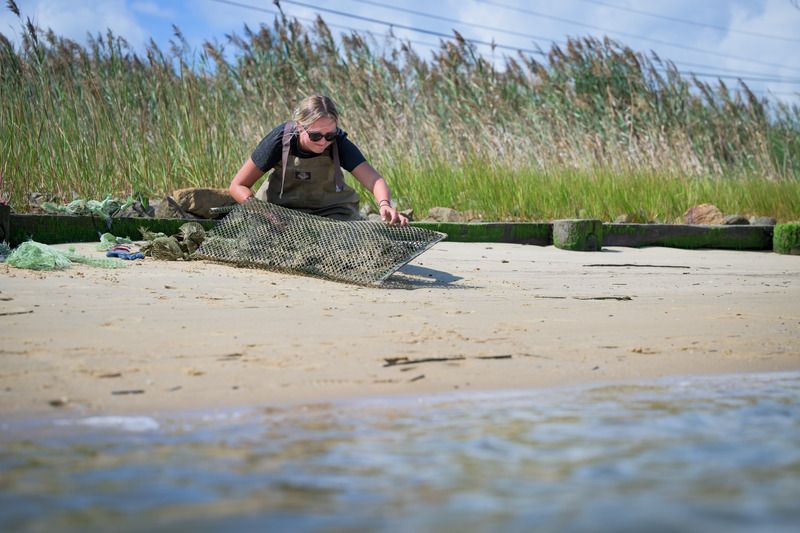


Assessing living shorelines
Photos by Evan Krape October 25, 2023
UD project looks to oysters to enhance shoreline resilience
Coastal wetlands provide important functions for estuaries, including reducing pollutants, providing habitat for plants and animals, and offering protection from storms and flooding events. In the Delaware Estuary, these beneficial wetlands are estimated to lose about one acre per day. Some models, when taking into account a one-meter rise in sea level, predict that by 2100, more than a quarter of the total wetlands of the Delaware Estuary could be lost.
As sea level rise continues to increase nationwide, it brings with it the likelihood of flooding and an increase of coastal hazards such as erosion. All buildings located along the coast are threatened by these developments and even robust infrastructure like United States military installations are not immune from the threat.
To provide possible solutions to help save these installations, as well as to help protect the wetlands and residential homes along the coast, researchers at the University of Delaware are exploring ways to help build coastal resilience while also providing benefits to the Delaware Bay ecosystem.
Installing living shorelines — protected and stabilized shorelines made of natural materials like oysters, plants, sand or rock — along the Delaware Bay could provide benefits such as addressing the declining oyster populations that have occurred over the last hundred years, as well as stabilizing the shoreline and reducing nutrient pollution.
The project, Developing Engineering Practices for Ecosystem Design Solutions, or DEEDS project, is funded through a Department of Defense appropriation and is a collaboration among the U.S. Army Engineer Research and Development Center, UD and Louisiana State University. The project is coordinated by the Delaware Environmental Institute (DENIN).
Good DEEDS
The project is led at UD by Jack Puleo, professor and chair of the Department of Civil and Environmental Engineering, and Jules Bruck, an affiliated faculty member at UD and director of the University of Florida’s School of Landscape Architecture and Planning.
It looks to inform the Army about land-use management designs to enhance the resilience of military missions and operations in present and future terrains by using ecosystem services to address threats posed by climate and coastal hazards.

“In a nutshell, we are investigating the use of hybrid living shoreline solutions incorporating shellfish,” Puleo said. “We have identified areas of interest, will use rubrics to finalize site selections, conduct some more detailed studies on those sites, and then install a living shoreline and monitor it.”
Monique Head, associate professor in the Department of Civil and Environmental Engineering; Eric Bardenhagen, associate professor in the Department of Plant and Soil Sciences; Danielle Kreeger, an ecologist at the Partnership for the Delaware Estuary (PDE); and Kurt Cheng, shellfish programs manager with the Partnership for the Delaware Estuary, are all co-principal investigators on the project.
Bruck said the project is going to study the possibility of using shellfish-based living shorelines to help coastal communities.
This will be done in various sections, as the engineering faculty and students will look at the amount of wave energy that is dissipated through oyster-based living shorelines and how that might help prevent infrastructure damage to roads and bridges, as well as saltwater intrusion into infrastructure in the uplands farther away from the coast.
"Eric Bardenhagen and I will examine the transformation of land use in upland areas and assess the potential impact of such changes on the shoreline,” Bruck said. “This encompasses a wide range of land-use alterations, such as the conversion of forested or agricultural land to housing developments or any other modifications in land utilization.”
The project addresses various factors, including coastal squeeze resulting from upland urbanization, alterations in upland land cover, and the escalating wave energy and sea-level rise, Bruck said.
“Our objective is to investigate whether shellfish, known as ecosystem engineers capable of constructing their own habitats, could contribute to mitigating the effects of fluctuating water levels and enhancing the resilience of coastal communities,” she said.
Working on Lewes test sites
Ed Hale, who is a co-principal investigator on the project, assistant professor in UD’s School of Marine Science and Policy, and fisheries and aquaculture specialist for Delaware Sea Grant, as well as postdoctoral researcher Brendan Campbell and graduate student Rileigh Hudock, are involved in researching the shellfish aspect of the project.
This past summer, Campbell, Hale and Hudock spent time working on site assessment in the Delaware Bay and set up two test sites located near UD’s Hugh R. Sharp Campus in Lewes.

For the site assessments, Campbell and Hudock traveled up and down the state of Delaware — from Collins Beach in New Castle County down to Lewes, Delaware — looking at five specific locations to figure out the best place for the initial shellfish installations. They did this by exploring the areas using mapping software and conducting preliminary site investigations for site suitability, including determining relative sediment composition.
Hudock plans to work to put together a habitat sustainability index to determine where the oysters are going to grow best in Delaware and what is going to be the scale of their productivity. The goal is to produce a series of maps where wild recruitment occurs, where the survival of farmed oysters can occur and where best to plant oysters up and down the state so that if anybody wants to take this data at a later date, they could potentially use the results to inform management practices.
“I have about a year to make an entire habitat suitability index of the Delaware Bay,” Hudock said. “I will use graphic information system software, which will add a spatial component to show the relationships between all of the different co-variants that we’re looking at.”
Hale’s role is to assess shellfish recruitment for wild shellfish stock as well as the growth and survival of farmed shellfish, and assess ecosystem benefits in the form of juvenile and forage fish habitat occupancy at the installations along an estuarine gradient.
Campbell will look at fish habitat provisioning to see which types of fish will be using the living shorelines.
“When you create all of that structure, it draws in smaller, juvenile fish, some of which are very important for commercial and recreational fisheries and overall ecological balance,” Campbell said. “We want to quantify what species of fish are being brought into these structures and the radius of that influence the structures provide.”
For instance, if the researchers use a cage of oysters to act as a model living shoreline, they could investigate the effect on local fish populations directly on those cages, and the effects on local fish populations 30 meters out from those cages.

Hudock said that in addition to fish recruitment, having oyster reefs installed in these living shorelines could provide other ecosystem services.
“It helps prevent hydrodynamic forcing, helps habitat provisioning like what Brendan is looking at in his study in terms of being a nursery habitat and additional habitat for these fish species,” Hudock said. “Oysters also filter water. They help out with water filtration as well as nutrient burial.”
Campbell added, “When you have excess nitrogen in the water, you can have oysters come in and take away that excess nitrogen. It can help you control algal blooms and things along those lines. Oysters can try to reduce the algae a little bit since they are actively filtering it and feeding on them.”
The researchers are hoping these living shoreline solutions can help residential communities and military installations be better prepared for coastal inundation while also helping to provide important environmental benefits.
“There’s a suite of military installations up and down the eastern seaboard of the United States that are undergoing the same threats to climate change and sea level rise that residential communities are,” Hale said. “Our thought is that you can actually use these living shorelines to protect those installations, while also using these natural resources to aquaculture oysters, produce a crop, generate economic benefits and ecosystem benefits by habitat provisioning for small fishes, and so we’re trying to assess that impact.”
Contact Us
Have a UDaily story idea?
Contact us at ocm@udel.edu
Members of the press
Contact us at 302-831-NEWS or visit the Media Relations website

